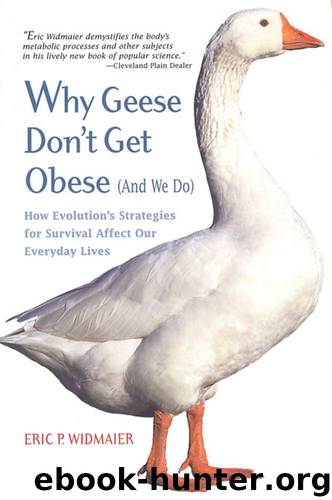Why Geese Don't Get Obese (And We Do) by Eric P. Widmaier

Author:Eric P. Widmaier
Language: eng
Format: epub
Published: 2019-03-17T16:00:00+00:00
It All Begins in the Brain
Generally speaking, whenever you look for a control mechanism of a behavior, you’re likely to find it within the brain. Eating is no exception. It turns out there are well-defined centers, called nuclei, within the brain that make us feel hungry or full. 1 However, the brain doesn’t work on its own. It gets signals from the stomach, the eyes, the nose, and other regions. These signals may tell the brain that food is available, that the stomach is no longer stretched by food and therefore needs to be filled again, and so on. But how does the brain get information from these other areas of the body? In general, there are two ways in which the brain can communicate back and forth with other structures. The first is by neural signals that travel up and down the spinal cord and throughout the brain. The second is by hormones that are released into the blood and act on cells of the brain.
Let’s take the case of the neural signals first. Scientists have long been aware that there are nuclei within a critical region of the brain called the hypothalamus, which regulates both feeding and metabolism. Although the hypothalamus is tiny and weighs less than one-seventh of an ounce, it is extremely important to a variety of functions. Located in the middle of the bottom of the brain, the hypothalamus contains many nuclei, which regulate such diverse activities as reproduction, sleep/wake rhythms, emotions, body temperature, hormone secretion, and feeding and metabolism. Right below it and connected by a thin strand of tissue is the pituitary gland. This is one of the chief hormone glands of the body and is the interface between the brain and the other hormone glands, such as the adrenals and thyroid.
Several lines of evidence have narrowed the feeding-related sites in the hypothalamus to a few specific nuclei, such as the ventromedial nuclei (VMN) and the lateral hypothalamic area (LHA). (The names refer to the geographical coordinates of where within the hypothalamus the nuclei reside.) We know, for example, that in lesioning experiments, if the VMN are obliterated by a jolt of electric current, animals overeat. In fact, a rat whose VMN have been destroyed will become so ridiculously obese that it won’t be able to turn around in its cage. On the other hand, if the VMN are stimulated, eating will stop altogether. Thus, we might say that the VMN are a satiety center, and without the normal operation of the VMN neurons, an animal continues eating until it is almost ready to burst.
VMN-lesioned rats don’t explode, of course, but they do get awfully ornery. In fact, their behavior changes remarkably from a docile laboratory rat to an aggressive animal that also shows changes in sexual behavior. This unexpected effect is a very good example of the difficulties in determining the specific functions of different brain regions. When you destroy an area like the VMN, you can’t be sure other problems haven’t been created as well.
Download
This site does not store any files on its server. We only index and link to content provided by other sites. Please contact the content providers to delete copyright contents if any and email us, we'll remove relevant links or contents immediately.
Sapiens: A Brief History of Humankind by Yuval Noah Harari(14320)
Sapiens by Yuval Noah Harari(5322)
Pale Blue Dot by Carl Sagan(4954)
Homo Deus: A Brief History of Tomorrow by Yuval Noah Harari(4871)
Livewired by David Eagleman(3729)
Origin Story: A Big History of Everything by David Christian(3666)
Brief Answers to the Big Questions by Stephen Hawking(3393)
Inferior by Angela Saini(3293)
Origin Story by David Christian(3170)
Signature in the Cell: DNA and the Evidence for Intelligent Design by Stephen C. Meyer(3098)
The Gene: An Intimate History by Siddhartha Mukherjee(3074)
The Evolution of Beauty by Richard O. Prum(2963)
Aliens by Jim Al-Khalili(2803)
How The Mind Works by Steven Pinker(2777)
A Short History of Nearly Everything by Bryson Bill(2659)
Sex at Dawn: The Prehistoric Origins of Modern Sexuality by Ryan Christopher(2500)
From Bacteria to Bach and Back by Daniel C. Dennett(2462)
Endless Forms Most Beautiful by Sean B. Carroll(2443)
Who We Are and How We Got Here by David Reich(2418)
